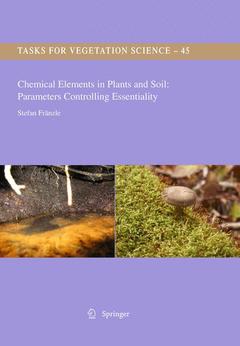Chemical Elements in Plants and Soil: Parameters Controlling Essentiality, 2010 Tasks for Vegetation Science Series, Vol. 45
Auteur : Fränzle Stefan

Earlier works on plant essential elements have revealed a series of complicated, counter-intuitive relationships among various chemical elements in different plant species, due to both unlike usage of certain elements in plants and to different carriers effecting resorption and transport.
In an attempt to provide a more coherent theory behind plant mineral nutrition, this groundbreaking book adopts a very different approach from the existing literature, presenting an explanation of the essentiality of chemical elements in biological systems and the application of stoichiometric network analysis (SNA) to the biological system of elements. Starting with data from biochemical environmental analysis, and a discussion of the phenomena involved in metal ion partition and autocatalytic behaviour, conditions and criteria controlling the partition of metals into biomass are investigated. Several rules are derived and investigated in terms of their interaction both in comparisons among contemporary organisms and in terms of evolution. This allows the construction, for example of a map which directly traces the biological feature of essentiality to parameters of coordination chemistry.
The book will have worldwide appeal for researchers interested in fields such as soil/plant interactions, bioinorganic chemistry, plant nutrition, phytomining, bioremediation, biogeochemistry, nutrient cycling, soil chemistry, and cellular physiology.
Introduction.- 1. The biological System of Elements. - 1.1. Principles of Element Distribution in Plants.- 1.1.1. Distribution Patterns of Chemical Elements in Plants.- 1.1.2. Biochemical Essentiality of Elements in the Light of Enzymatic Reactions.- 1.1.3. Soil and Geochemistry: Support and Storage/Buffer System for Biology.- 1.2. Methodology of Inquiries into the Biological System of Elements.- 1.2.1. Correlation Analysis of Element Distribution in multiple Plant Species.- 1.2.2. Fundamentals of the Correlation-Chemical Analysis of Element Abundances.- 1.2.2.1. Stoichiometric Network Analysis.- 1.2.2.2. Biophysical Implication of Gibbs´s Phase Rule.- 1.2.2.3. Aqueous Coordination Chemistry related to Metal Uptake.- 2. Autocatalytic Processes and the Role of Essential Elements in Plant Growth.- 2.1. Biomass Stability in the Light of Gibbs´s Phase Rule.- 2.2. Coordination-Chemical Control of Element Uptake.- 2.2.1. Electrochemical parameters of Biologically relevant Ligands.- 2.2.2. A Method to Calculate Metal-Ligand Association Equilibria.- 2.2.3. How does the Electrochemical Ligand Parameter influence real vs. possible Hapticity of some Polydentate Ligand?.- 2.2.4. Translating Complex Stabilities into BCF Data: the k´ Term of Element Fractionation.- 2.2.5. Binding Stability of Substrates and Products in Catalytic Cycles: How does Ligand Sensitivity influence Reaction Kinetics?.- 2.2.6. The Electrochemical Ligand Parameter, Metal Affinities and Chemical Ecology.- 2.2.7. Implication of Some Theoremes from Stoichiometric Network Analysis (SNA) with respect to Stability and Functions of Biochemical Systems.- 2.2.8. Matter (Flow) Balance and Estimation of Loss Processes (exit order) Within Autocatalytic Biochemical Cycles.- 2.2.9. The Topology of Autocatalytic Feedback Patterns in Living Systems.- 2.2.10. SNA and Metal Transport in Terrestrial Plants.- 2.2.11. Stoichiometry of Terrestrial Plants and its Implications according to SNA.- 2.2.12. A Comprehensive Analysis of Autocatalytic Processes within Some Photosynthetic Plant.- 2.3. Some Remarks on Chemical Ecology.- 2.3.1. Constraints of Essentiality caused by Consumers.- 2.3.2. Trophic Nets.- 2.3.3. Different Kinds of Energy Metabolism and C/N plus C/Metal, Intermetal Ratios.- 2.3.4. Succession and Ecological Stoichiometry in Certain Biotopes.- 3. A Causal Model of Biochemical Essentiality.- 3.1. Influence of Intrinsic Bonding Stability and Ligand Sensitivity on the Biocatalytic Properties of Metal Ions.- 3.2. Complex Stability in Relation to other Bioorganic Parameters.- 3.3. Scope of the Essentiality Model.- 4. The Evolution of Essentiality.- 4.1. Evolution and Biochemical Catalysis.- 4.2. The Three-Function-Rule as a Controlling Factor in the Origins of Essentiality.- 4.3. Biogeochemical Fractionation Processes and essentiality Patterns in Different Taxa under Changing Biogeochemical Boundary Conditions.- References.
Novel thinking on plant nutrition
Good summary of extensive publication outputs over past 10 years
A correlation between bioinorganic chemistry and systems biology
A/n (evolutionary) model of biochemical essentiality of chemical elements
Date de parution : 11-2014
Ouvrage de 196 p.
19.3x26 cm
Disponible chez l'éditeur (délai d'approvisionnement : 15 jours).
Prix indicatif 158,24 €
Ajouter au panierDate de parution : 12-2009
Ouvrage de 196 p.
19.3x26 cm



